Types Of Welding Pdf Free Download
In this article, you'll learn what is welding? 10 different types of welding processes with their working, advantages, disadvantage, applications, and more.
And also you can download the PDF file of this article at end of it.
What is Welding?
Welding is a permanent joining process in which two pieces of metal together to form one piece by heating the metals to their melting points. Additional metal also called filler metal is added during the heating process to help bond the two pieces together.
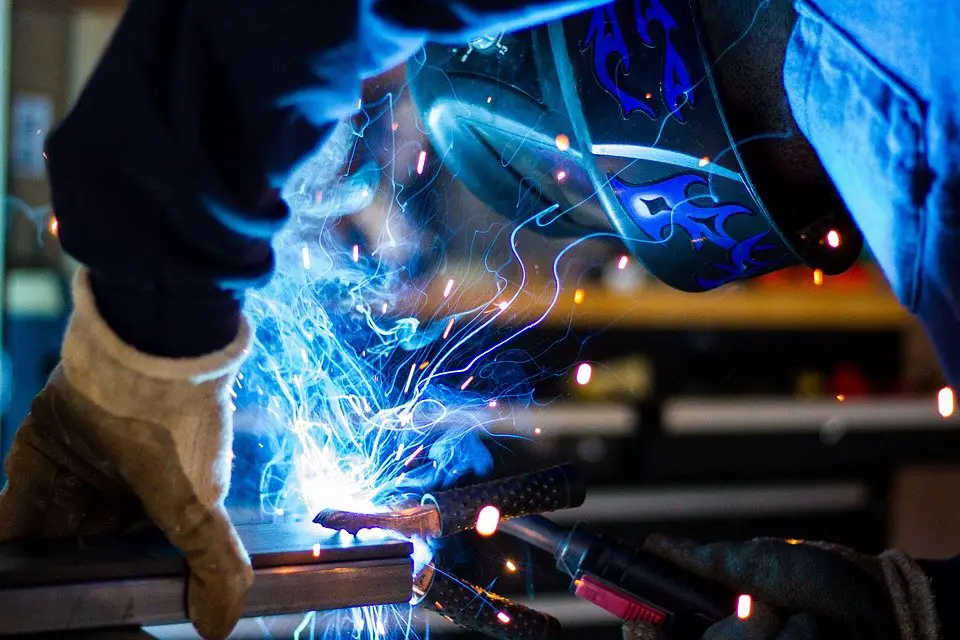
In general, it is a process in which two metal pieces similar (or) dissimilar may be joined by heating them to a temperature high enough to fuse the metals with (or) without the application of pressure and with (or) without the aid of filler material.
Welding Machine
A welding machine is used to create the heat and apply the filler metal. The filler metal is supplied to form the joint, either from the electrode itself (or) by filler material. The temperature of the heat produced is of the order of 6000° to 7000°c. So, let's discuss what are the different types of welding processes, and how they are used in Industries?
Read also:
- TIG & MIG Welding: Difference Between TIG and MIG welding
- How Does UnderWater Welding Works? and Types of Underwater Welding
Types of Welding Processes
The following are types of welding processes according to the method of heat generated:
- MIG welding
- Stick welding
- TIG welding
- Plasma Arc welding
- Electron beam welding
- Laser beam welding
- Gas welding
- Flux cord arc welding
- Automic hydrogen welding
- Electroslag welding
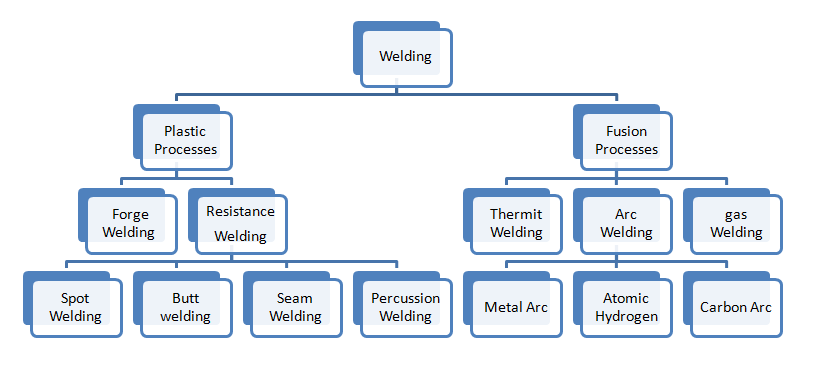
1. MIG Welding
MIG welding holds for metal inert gas welding. This MIG welding process is also identified as gas metal arc welding (GMAW) which you can also call wire welding.
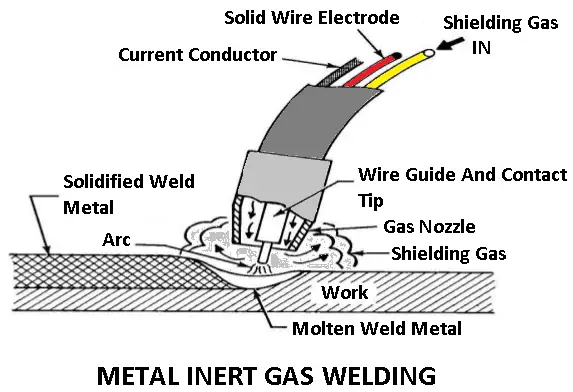
In this types of welding, a thin wire works as the electrode which is fed from a spool attached on a gun through a flexible tube and comes out of the nozzle on the welding gun or torch. The wire is fed continuously when the trigger is pulled on the welding gun.
2. Shielded Metal Arc Welding (SMAW)
It is also identified as hand-operated metal arc welding, flux shielded arc welding, or stick welding. In this type of welding process in which the arc is struck between the metal rod or electrode (flux coated) and the workpiece, the surface of both the rod and the workpiece melting to create a weld pool.
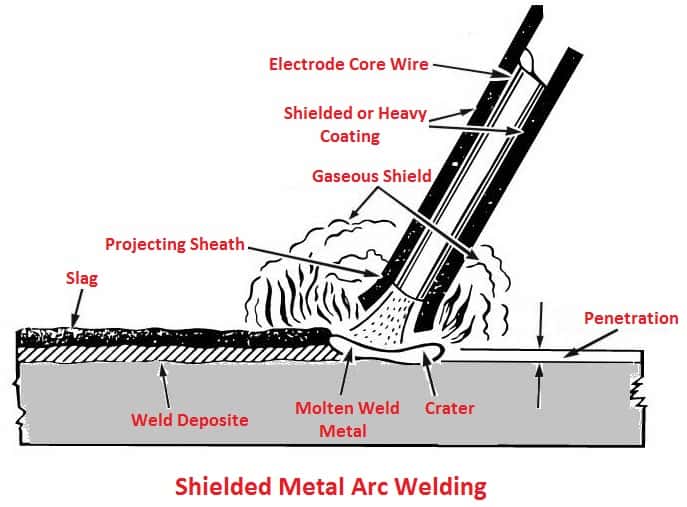
The simultaneous melting of the flux coating on the rod will produce gas and slag, which shields the weld joint from the environment. Shielded metal arc welding is a various process ideal for joining ferrous and non-ferrous materials with the thickness of the material at all positions.
3. TIG Welding
TIG welding stands for tungsten inert gas arc welding, from American welding society it is also identified as (GTAW). This welding process is likewise called as gas welding.
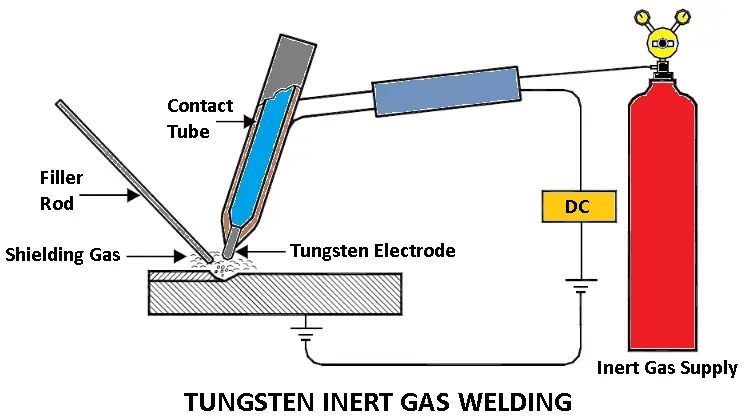
TIG welding employs a tungsten electrode because tungsten has a high melting point. When we take the tig weld electrode gets hot but it doesn't melt we say that is a non-consumable electrode. Non-consumable electrodes do not mean that it does not last forever and it means that it does not melt and becomes part of the weld.
4. Plasma Arc Welding (PAW)
Plasma arc welding (PAW) is an arc welding process utilizing heat generated by a compressed arc between a tungsten non-consumable electrode and workpiece (transferred arc process) or water-cooled constricting nozzle (non-transferred arc process).
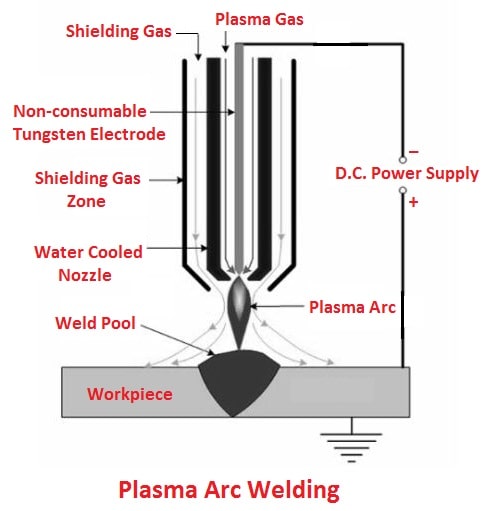
The plasma is a gaseous mix-up of positive ions, electrons, and neutral gas molecules. The transferred arc process creates plasma jets of high energy density and can be used for high-speed welding and cutting ceramics, copper alloys, steels, aluminum, nickel alloys, and titanium alloys.
5. Electron Beam Welding (EBW)
Electron beam welding is a welding process that applies the heat created by a beam of high energy electrons. The electrons hit the workpiece and their kinetic energy is converted into thermal energy heating the metal so that the edges of the workpiece can be connected and a weld is formed after freezing.
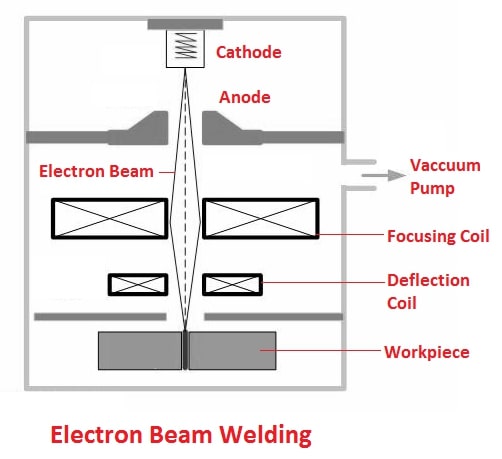
EBM is also a liquid state welding process. In which, the metal-to-metal joint is made in a liquid or molten state. It is also described as a welding process because it accepts electrons kinetic energy to join two metal workpieces.
6. Laser Beam Welding (LBW)
Laser Beam Welding (LBW) is a welding process, in which heat is formed by a high energy laser beam targeted on the workpiece. The laser beam heats and melts the ends of the workpiece, making a joint.
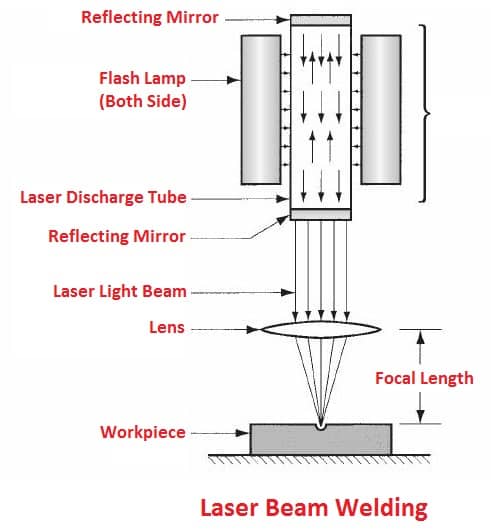
In laser welding (LBM) the joint is formed as a sequence of overlapped spot welds or as a continuous weld. Laser welding is employed in the electronics, communications, and aerospace industries, to manufacture medical and scientific equipment, incorporating small components.
7. Gas Welding
Gas welding is performed by melting the sides or surfaces to be connected by gas flame and providing the molten metal to flow together, thus creating a solid continuous joint upon cooling.
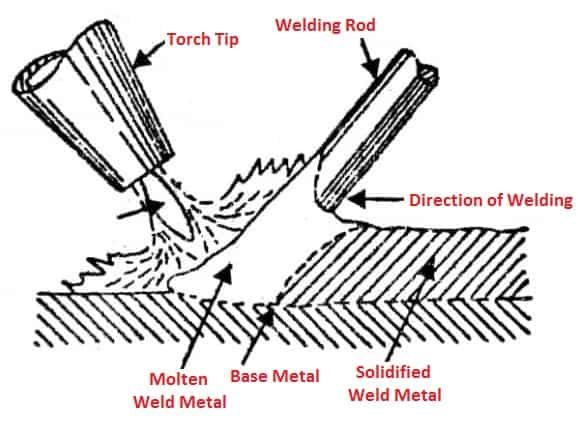
Oxygen-acetylene mixtures are used to a very greater extent than others and hold a prominent position in the welding industry. The temperature of the oxy-acetylene flame in its hottest area is about 3200°C, while the temperature reached in the oxy-hydrogen flame is about 1900°C.
8. Flux Cored Arc Welding (FCAW)
This type of welding is almost similar to MIG welding. In fact, MIG welders can often perform flux-cored arc welding. In this welding, the wire has a core of flux that forms a gas shield around the weld. This reduces the demand for external gas supply.
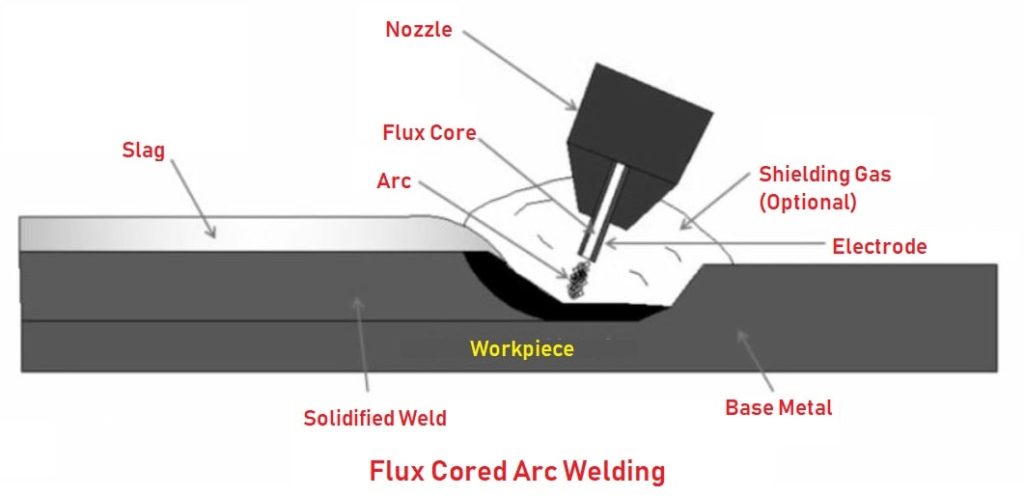
FCAW is better suited for rough, heavy metals because it is a high heat welding process. It is usually used for heavy equipment repair for this purpose. It is a process that does not produce too much waste. Because there is no need for external gas, it also costs less.
9. Atomic Hydrogen Welding
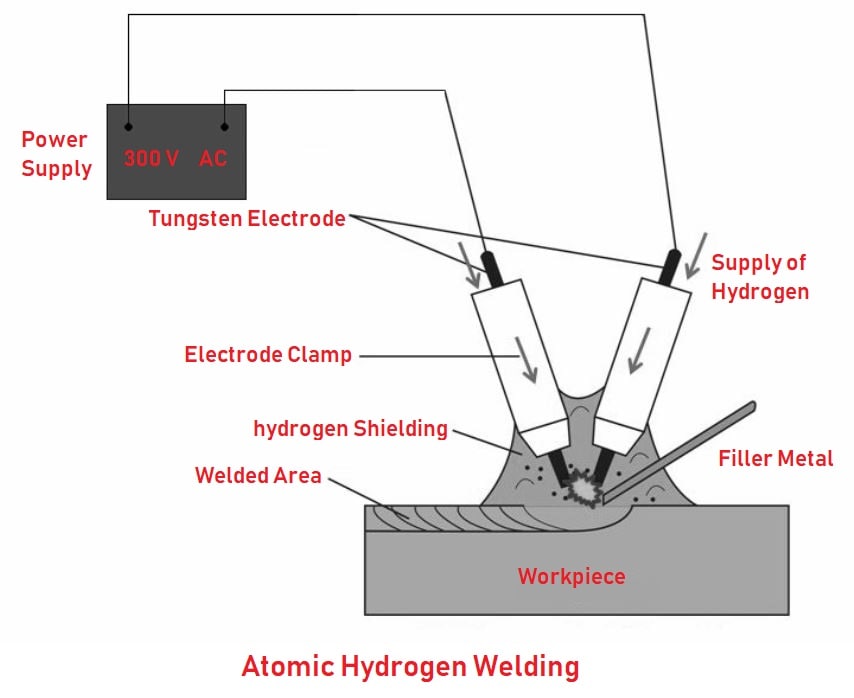
Atomic hydrogen welding is an extremely high-temperature form of welding known as arc-atomic welding. This type of welding requires using hydrogen gas to shield two electrodes formed of tungsten. It can reach temperatures above an acetylene torch and it can be done with or without filler metal.
10. Electroslag Welding
It is an advanced welding process that is used to connect the thin ends of two metal pieces vertically together. Instead of the weld being used to the outside of a joint, it will take place between the ends of the two pieces.
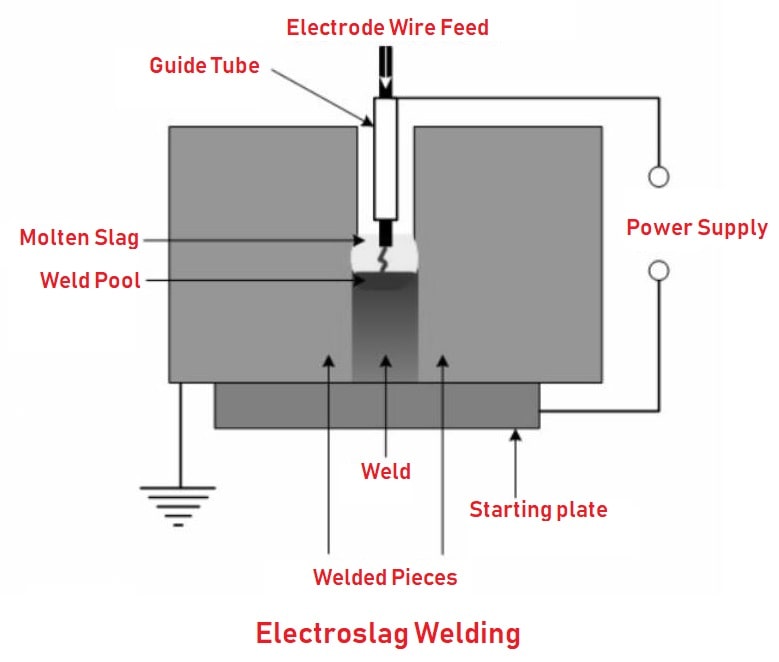
A copper electrode wire is fed through a metal guide tube that will act as a filler metal. When power is added, the arc is produced, and a weld is started below the seam and moved up slowly, creating a weld in place of the seam.
Types of Welding Positions
Following are the four main types of welding positions:
- Flat Position (1G and 1F)
- Horizontal Position (2G and 2F)
- Vertical Position (3F and 3G)
- Overhead Position (4G and 4F)
1. Flat Position
The most obvious type to perform is the flat position, sometimes called the down hand position. This involves welding at the top of the joint. In this case, the molten metal is pulled downward at the joint. The result is a quicker and easier weld.
In 1G and 1F, number 1 relates to the flat position, while letter G is for a groove weld and letter F is for a fillet weld.
2. Horizontal Position (2G and 2F)
This is a more difficult position than the flat position and requires more skill from the welding operator to correct it.
2G is a groove weld position that includes placing the weld axis in a horizontal plane or nearly horizontal. For the face of the weld, it must lie about in a vertical plane.
2F is a fillet weld position, in which welding is performed on the upper side of surfaces that are nearly horizontal against a surface that is nearly vertical. In this position, the torch is normally kept at an angle of 45 degrees.
3. Vertical Position (3F and 3G)
In this position, both the piece and the weld lie vertically or nearly vertically. 3F and 3G lead to the vertical fillet and vertical groove positions.
When welding is done vertically, the force of gravity pushes the molten metal downward and therefore has a tendency to stack. To counteract this, you can use an upward or downward vertical position.
To check it in an upward vertical position, point the flame upward, placing it at an angle of 45 degrees to the piece. In this way, the welder will apply metal from the lower parts of the workpiece to weld toward the force of gravity.
4. Overhead Position (4G and 4F)
In this type of welding position, welding is performed from the bottom of the joint. It has the most complex and difficult position to work with. The 4G and 4F positions are for groove and fillet welds.
In the overhead position, the metal deposited to the joint leads to a hole on the piece, occurring in a bead with a higher crown. To avoid this, keep the molten puddle small. If the weld puddle becomes too long, eliminate the flame for a moment in order to allow the molten metal to cool.
Advantages of Welding Process
- A good weld will be stronger than the parent or base metal.
- Faster process compared to riveting and casting.
- Complete rigid joints can be provided with the welding process.
- Applicable to all metals and alloys.
- Difficult shapes can be produced by welding.
- Welding equipment is portable and can be easily maintained.
- No noise is produced during the welding process as in the case of riveting.
- The welding process requires less workspace in comparison to riveting.
- Any space of the joint can be made with ease.
Disadvantages of Welding Process
- Gives out harmful radiation, fumes, and spotless (a sudden sprinkle of spark).
- Welded joints are more breakable and hence their fatigue strength is less than the members joined.
- Results in distortion and induces internal stresses.
- It needs certain jigs and fixtures to hold metals properly.
- Skilled workers and electricity are needed for welding.
- The inspection of welding work is more difficult and costlier than the riveting work.
Applications of Welding
The application of welding is so different and large that it would be no exaggeration to say that there is no metal industry and no branch of engineering that does not make use of welding in one form or another namely automobile industry, shipping, aerospace, and construction. It is majorly used for fabrication.
Some of the application are:
- Shipbuilding
- Railway coaches
- Automobile chassis and bodybuilding
- Earthmover bodies
- Window shutters
- Doors, gates
- All types of fabrication work.
Conclusion
As you know now, Welding is a strong joining process in which two parts of metal together form one part by heating the metals to their melting points. Some types of welding are made by machines and need costly specialized equipment. Welding is a faster method related to riveting and casting.
we hope that we have clear all your doubts aboutWelding Process. If you have still any doubts about the "Types of Welding Process" you can contact us or ask in the comments.
We have also a Facebook community for you guys, if you want, you can join our community, here is the link to our Facebook group.
That's it thanks for reading. If you like our article then please share it with your friends. If you have any questions about any topic you can ask in the comment section.
Download PDF of this article
Subscribe to our newsletter to get notification of our new posts.
You might like to read more on our blog:
Source: https://www.theengineerspost.com/types-of-welding/
Posted by: gradymontanoe0182771.blogspot.com
Posting Komentar untuk "Types Of Welding Pdf Free Download"